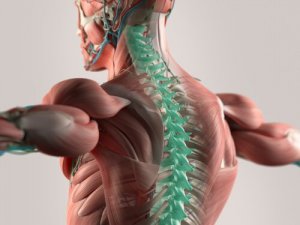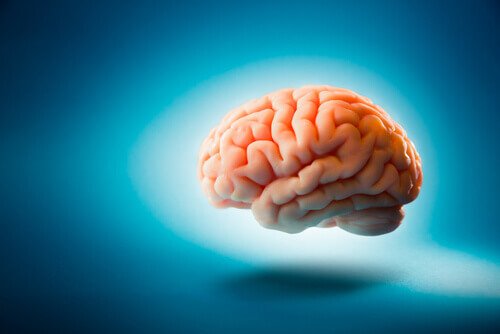The Cerebrospinal Fluid: The Foundation of the Central Nervous System

The cerebrospinal fluid (CSF) is one of the main fluids of the human body. Its main function is to protect the brain tissue and the spinal cord. It serves as a cushion against impacts to the central nervous system, the cranium, and its surrounding bones. In normal conditions, the CSF has a volume between 100 and 150 milliliters.
It’s transparent, and its chemical content is different from the one in serum but similar to the one in blood plasma. It also has the same consistency as water. Its main composition is H2O, minerals (sodium, potassium, calcium, chlorine), inorganic salts (phosphates), and vitamins (especially B vitamins). It contains electrolytes, leukocytes, amino acids, choline, nucleic acid, and others.

An extracellular type of fluid
The body has 4 compartments of fluids, divided into intracellular and extracellular. Approximately 2/3 of the total amount of water in our body is either intracellular or intravascular fluid. That’s the liquid part of the cytoplasm of the cells. The rest is extracellular. As a matter of fact, there are three types of extracellular fluid:
- Blood plasma: Meaning the liquid portion of the blood. The one in blood vessels and heart chambers.
- The interstitial type, lodged in the interstice or space between the cells.
- Lastly, the cerebrospinal fluid, which bathes the brain and the spinal cord.
Now let’s delve deeper into its composition, localization, and function.
Localization and circulation
The CSF circulates through the subarachnoid space, the brain ventricles, and the ependymal canal. Let’s divide it into parts:
- The subarachnoid space is the one between the intermediate meninge (arachnoid) and the innermost (pia mater). The pia mater is in contact with the brain surface. Thus, the small space through which the CSF circulates separates the cranium from the brain.
- The cerebral ventricles: These are four interconnected anatomical cavities that are located in the brain. Together, they form the ventricular system, through which the CSF circulates.
- The ependymal canal: This is a conduit that runs through the whole spinal cord. It contains more than 140 milliliters of cerebrospinal fluid. It’s in the center of the spinal cord, located in the middle of the gray commissure, dividing it into an anterior and posterior part.
Synthesis and journey of the CSF
Most of the CSF is created from the blood plasma in the choroid plexuses of the cerebral ventricles. Once it’s synthesized, it goes to the lateral ventricles (located in both brain hemispheres). Lastly, it goes to the third ventricle, which is situated at the level of the diencephalon, through the interventricular holes.
From there, it goes through the aqueduct of Sylvius and ends up in the fourth ventricle, which has a triangular shape and is located in the rhombencephalon, very close to the brain stem and the cerebellum. Once the journey is ready, it goes to the subarachnoid space through the Magendie and Luschka hole and bathes the entire surface of the central nervous system.

Lastly, it’s reabsorbed in the venous sinuses (a passive process that doesn’t require energy). In normal conditions, the CSF reabsorbs very quickly, almost at the same speed in which it forms in the choroid plexuses. This makes intracranial pressure always constant.
The CSF renews approximately 6 or 7 times a day and its average cycle doesn’t usually exceed 3 hours. When the conduits through which the CSF circulates obstruct and the CSF accumulates in a compartment of the brain, that’s when hydrocephalus occurs. The immediate consequence is an increase in intracranial pressure.
Functions of the cerebrospinal fluid
The cerebrospinal fluid has many different functions:
- It protects the central nervous system against possible trauma, strokes, and impacts. It’s safe to say it’s capable of cushioning intracranial movement by up to 97%.
- It assumes a double biological function. On one hand, nutrition, because it’s in charge of transporting hormones, antibodies, and lymphocytes to the nervous tissue. On the other hand, disposal, because it discards the neuronal metabolic residue.
- It acts as an electrical insulator of the spinal cord.
- It helps diagnose a series of neurological diseases, alterations in the meninges, subarachnoid hemorrhages, or cerebrospinal tumors.
- It’s the route of entry for epidural anesthesia.
As you can see, the CSF is essential for the maintenance and the preservation of the central nervous system. Small changes in its density or quantity could produce severe consequences in the functioning of the brain.
The cerebrospinal fluid (CSF) is one of the main fluids of the human body. Its main function is to protect the brain tissue and the spinal cord. It serves as a cushion against impacts to the central nervous system, the cranium, and its surrounding bones. In normal conditions, the CSF has a volume between 100 and 150 milliliters.
It’s transparent, and its chemical content is different from the one in serum but similar to the one in blood plasma. It also has the same consistency as water. Its main composition is H2O, minerals (sodium, potassium, calcium, chlorine), inorganic salts (phosphates), and vitamins (especially B vitamins). It contains electrolytes, leukocytes, amino acids, choline, nucleic acid, and others.

An extracellular type of fluid
The body has 4 compartments of fluids, divided into intracellular and extracellular. Approximately 2/3 of the total amount of water in our body is either intracellular or intravascular fluid. That’s the liquid part of the cytoplasm of the cells. The rest is extracellular. As a matter of fact, there are three types of extracellular fluid:
- Blood plasma: Meaning the liquid portion of the blood. The one in blood vessels and heart chambers.
- The interstitial type, lodged in the interstice or space between the cells.
- Lastly, the cerebrospinal fluid, which bathes the brain and the spinal cord.
Now let’s delve deeper into its composition, localization, and function.
Localization and circulation
The CSF circulates through the subarachnoid space, the brain ventricles, and the ependymal canal. Let’s divide it into parts:
- The subarachnoid space is the one between the intermediate meninge (arachnoid) and the innermost (pia mater). The pia mater is in contact with the brain surface. Thus, the small space through which the CSF circulates separates the cranium from the brain.
- The cerebral ventricles: These are four interconnected anatomical cavities that are located in the brain. Together, they form the ventricular system, through which the CSF circulates.
- The ependymal canal: This is a conduit that runs through the whole spinal cord. It contains more than 140 milliliters of cerebrospinal fluid. It’s in the center of the spinal cord, located in the middle of the gray commissure, dividing it into an anterior and posterior part.
Synthesis and journey of the CSF
Most of the CSF is created from the blood plasma in the choroid plexuses of the cerebral ventricles. Once it’s synthesized, it goes to the lateral ventricles (located in both brain hemispheres). Lastly, it goes to the third ventricle, which is situated at the level of the diencephalon, through the interventricular holes.
From there, it goes through the aqueduct of Sylvius and ends up in the fourth ventricle, which has a triangular shape and is located in the rhombencephalon, very close to the brain stem and the cerebellum. Once the journey is ready, it goes to the subarachnoid space through the Magendie and Luschka hole and bathes the entire surface of the central nervous system.

Lastly, it’s reabsorbed in the venous sinuses (a passive process that doesn’t require energy). In normal conditions, the CSF reabsorbs very quickly, almost at the same speed in which it forms in the choroid plexuses. This makes intracranial pressure always constant.
The CSF renews approximately 6 or 7 times a day and its average cycle doesn’t usually exceed 3 hours. When the conduits through which the CSF circulates obstruct and the CSF accumulates in a compartment of the brain, that’s when hydrocephalus occurs. The immediate consequence is an increase in intracranial pressure.
Functions of the cerebrospinal fluid
The cerebrospinal fluid has many different functions:
- It protects the central nervous system against possible trauma, strokes, and impacts. It’s safe to say it’s capable of cushioning intracranial movement by up to 97%.
- It assumes a double biological function. On one hand, nutrition, because it’s in charge of transporting hormones, antibodies, and lymphocytes to the nervous tissue. On the other hand, disposal, because it discards the neuronal metabolic residue.
- It acts as an electrical insulator of the spinal cord.
- It helps diagnose a series of neurological diseases, alterations in the meninges, subarachnoid hemorrhages, or cerebrospinal tumors.
- It’s the route of entry for epidural anesthesia.
As you can see, the CSF is essential for the maintenance and the preservation of the central nervous system. Small changes in its density or quantity could produce severe consequences in the functioning of the brain.
This text is provided for informational purposes only and does not replace consultation with a professional. If in doubt, consult your specialist.







